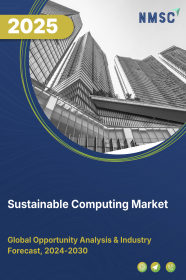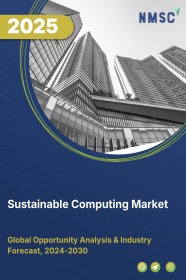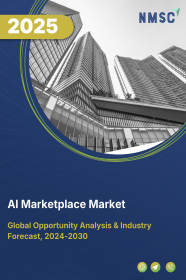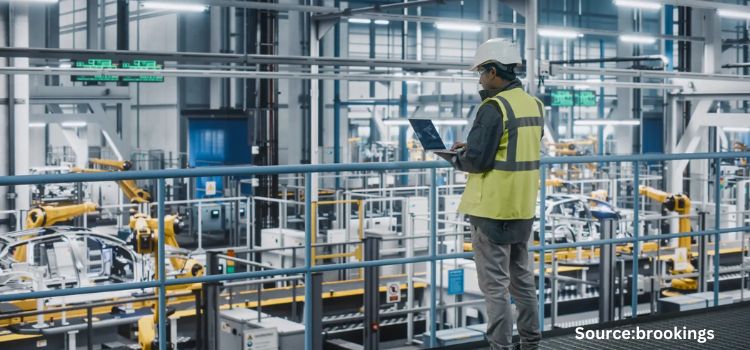
Sustainable Computing Market by Component (Hardware and Software), by Deployment (On-Premises, Cloud-Based, and Hybrid), by Technology (Liquid-Cooling Systems, Heat Reuse Systems, Renewable Energy Integration, Energy Storage Systems, and Efficient Power Management), by Application (Storage, Networking, Processing, and Cooling and Heating), and by End-User – Global Opportunity Analysis and Industry Forecast, 2025–2030
US Tariff Impact on Sustainable Computing Market
Trump Tariffs Are Reshaping Global Business
Sustainable Computing Market Overview
The global Sustainable Computing Market size was valued at USD XX billion in 2024 and is predicted to reach USD XXX billion by 2030 with a CAGR of XXX% from 2025-2030.
The sustainable computing sector is rapidly growing due to increasing energy costs, stricter environmental regulations, and a rising focus on Corporate Social Responsibility (CSR). Organizations are being compelled to adopt energy-efficient practices in areas like data centers and IT infrastructure to reduce costs, comply with regulations, and minimize their environmental footprint. As technologies such as Artificial Intelligence (AI) and High-Performance Computing (HPC) continue to drive up energy consumption, the demand for energy-efficient solutions is intensifying. However, high upfront costs for greener technologies remain a challenge, particularly for smaller businesses. Despite this, the sector presents significant opportunities for innovation, as companies develop energy-efficient hardware, optimized cooling systems, and energy-aware platforms.
Growing Financial and Legal Incentives for Sustainable Computing Drive the Market Growth
The escalating costs of energy and the increasing stringency of environmental regulations are acting as powerful catalysts for the sustainable computing market. Organizations are becoming acutely aware of the financial and environmental implications of their energy consumption, especially concerning data centers and large-scale IT infrastructures. For instance, data centers are known to be significant energy consumers, and rising electricity prices directly impact their operational expenses. Simultaneously, governments worldwide are introducing stricter regulations aimed at reducing carbon emissions and promoting energy efficiency. This dual pressure, including economic and regulatory is compelling businesses to explore and adopt sustainable computing practices to reduce costs, comply with regulations, and mitigate their environmental footprint.
The Rise of Corporate Responsibility and Green Demand Fuels the Market Growth
Businesses are placing greater focus on Corporate Social Responsibility (CSR), not just as a formality but as a key part of their brand and stakeholder engagement. Customers and investors are showing stronger interest in products and services that support environmental sustainability. This shift is creating strong demand for eco-friendly technologies, becoming a major driver for the sustainable computing market. Companies now see sustainable computing as a way to meet CSR goals while gaining a competitive edge by appealing to environmentally conscious buyers and investors. HP’s green computing efforts highlight this ongoing trend.
Rising Energy Impact of AI and HPC Drives the Market Trends
The rapid advancements and widespread adoption of energy-intensive technologies like Artificial Intelligence (AI) and High-Performance Computing (HPC) are significantly driving the need for sustainable computing. Training large AI models and running complex simulations in HPC environments requires immense computational power, leading to substantial energy consumption and a significant carbon footprint. This energy intensity is pushing the industry to seek more energy-efficient hardware, software, and operational practices. Companies like NVIDIA are actively focusing on accelerated AI and energy efficiency to address this growing demand. The development of frameworks to measure AI's energy use, such as the collaboration between JISEA and Intel, further highlights this driver.
High Upfront Costs Limit the Adoption of Sustainable Computing and Hinders Market Growth
One of the primary challenges hindering the widespread adoption of sustainable computing is the initial investment required. Implementing greener technologies and retrofitting existing infrastructure for better energy efficiency can involve significant upfront costs. For instance, transitioning to more energy-efficient servers, implementing advanced cooling systems in data centers, or adopting renewable energy sources can be a substantial financial undertaking. This can be a restriction, especially for smaller organizations or those with tight budgets, despite the long-term cost savings associated with reduced energy consumption.
Innovative Solutions Fuel Growth and Create Opportunities for Market Growth
The growing demand for sustainable computing presents a significant opportunity for technology providers to create innovative, energy-efficient hardware and software solutions. This includes developing processors with lower power consumption, optimizing cooling systems for data centers, refining software algorithms to reduce computational demands, and creating energy-aware computing platforms. Companies that can deliver high-performance computing with reduced energy footprints will be in high demand. The introduction of energy-efficient server lines by companies such as ZTE highlights this trend. Focusing on such innovations can lead to substantial market share gains in the rapidly growing sustainable computing sector, which is becoming a key component of the overall IT industry.
For instance, ZTE unveiled its G6 series servers in 2024, featuring enhanced energy efficiency and performance, underscoring the industry's commitment to green computing. This focus on innovation creates significant opportunities for businesses to drive sustainable practices and meet the growing demand for eco-friendly technology solutions.
Market Segmentation and Scope of Study
The sustainable computing market report is segmented by component, deployment, technology, application, end user, and region. On the basis of components, the market includes hardware and software. On the basis of deployment, the market is categorized into on-premises, cloud-based, and hybrid. On the basis of technology, the market is divided into liquid-cooling systems, heat reuse systems, renewable energy integration, energy storage systems, and efficient power management. On the basis of application, the market is segmented into storage, networking, processing, and cooling & heating. On the basis of end users, the market is classified into banking, financial services, and insurance (BFSI), healthcare and life sciences, IT and telecommunication, retail and e-commerce, manufacturing, government and defense, and energy and utilities. Regional breakdown and analysis of each of the aforesaid segments includes regions comprising North America, Europe, Asia-Pacific, and RoW.
Geographical Analysis
In North America, there's a strong emphasis on innovation and corporate responsibility driving the sustainable computing market. Major players such as NVIDIA are actively advancing accelerated AI and energy-efficient solutions, while also highlighting these priorities at prominent global forums. Initiatives around measuring the energy use of Artificial Intelligence, such as the collaboration between JISEA (National Renewable Energy Laboratory) and Intel, also highlight the region's focus on quantifying and addressing the environmental impact of computing.
Furthermore, academic institutions like Caltech are recognizing the importance of sustainable computing in the new world of AI, suggesting a strong research and development ecosystem. This reflects a strong commitment to embedding sustainability into core computing technologies, positioning North America as a key contributor to the global adoption of sustainable computing solutions.
Europe is demonstrating a strong commitment to sustainable computing through a combination of policy initiatives and technological advancements. The increasing focus on environmental regulations across the European Union is a significant driver for the adoption of green computing solutions. The Lisbon Council's research highlights the focus on sustainable computing as a pathway to a more sustainable planet, reflecting strong regional awareness and growing policy engagement in this area.
Moreover, the participation of European entities in global discussions on energy efficiency and the development of sustainable IT practices suggests a concerted effort to align technological growth with environmental sustainability goals. This positions Europe as a leading region in driving global trends and advancing the adoption of sustainable computing practices.
The Asia-Pacific region is also witnessing significant developments in the sustainable computing market, driven by rapid technological adoption and increasing environmental awareness. Singapore has launched green computing initiatives to promote sustainability in its tech sector, indicating proactive government support.
Furthermore, India is recognizing the need for a green computing infrastructure, suggesting a growing awareness and potential for significant growth in this large market. Companies like ZTE, while operating globally, have unveiled energy-efficient servers in overseas markets, which likely include the Asia-Pacific region, showcasing the availability of greener hardware options. The region's rapid technological progress, combined with growing environmental awareness, makes it a key area to monitor for future industry developments and overall growth.
The Rest of the World, while potentially less explicitly detailed in these sources, is also part of the global movement towards sustainable computing. The trends and drivers we've discussed, including increasing energy costs, corporate social responsibility, and the energy demands of technologies like AI, are global concerns that necessitate a worldwide shift. While specific initiatives and developments might not be as prominently featured in these sources for every corner of the globe, the overarching need for energy-efficient and environmentally responsible computing practices extends beyond the three major regions we've highlighted. Growing global awareness and the interconnected nature of the tech industry suggest that sustainable computing innovations emerging from North America, Europe, and Asia-Pacific will likely influence practices across other regions, supporting broader adoption and shaping future industry directions.
How NVIDIA, ZTE, and Other Notable Players Are Powering the Future of Sustainable Computing?
Leading companies in the sustainable computing industry are taking active steps to reduce environmental impact through innovation and strategic initiatives. One key trend is the development of energy-efficient hardware and software, especially important with the rising demands of technologies like Artificial Intelligence (AI). For example, NVIDIA is investing in solutions that combine accelerated AI with energy efficiency, while ZTE has launched energy-saving servers in international markets to support green computing infrastructure.
There is also a growing focus on measuring and managing AI’s energy use. A collaboration between JISEA and Intel is working to create a framework for tracking this more accurately. Additionally, companies are exploring carbon-aware computing, where workloads are scheduled based on the availability of renewable energy.
Despite these advancements, the industry still faces challenges. It remains complex to accurately measure the environmental footprint of computing systems, and sustainable practices are not yet widely adopted across all regions. However, global awareness around environmental concerns and the growing energy use of the tech sector are creating strong momentum for green computing solutions.
Emerging technologies like quantum computing are also being explored for their potential to support sustainability goals. The future of sustainable computing will rely on continued innovation, industry-wide standards, and collaboration to address environmental concerns in the digital age.
Key Benefits
- The report provides quantitative analysis and estimations of the sustainable computing market from 2025 to 2030, which assists in identifying the prevailing market opportunities.
- The study comprises a deep-dive analysis of the sustainable computing market including the current and future trends to depict prevalent investment pockets in the market.
- Information related to key drivers, restraints, and opportunities and their impact on the sustainable computing market is provided in the report.
- Competitive analysis of the players, along with their market share is provided in the report.
- SWOT analysis and Porters Five Forces model is elaborated in the study.
- Value chain analysis in the market study provides a clear picture of roles of stakeholders.
Sustainable Computing Market Key Segments
By Component
- Hardware
- Software
By Deployment
- On-Premises
- Cloud-Based
- Hybrid
By Technology
- Liquid-Cooling Systems
- Heat Reuse Systems
- Renewable Energy Integration
- Energy Storage Systems
- Efficient Power Management
By Application
- Storage
- Networking
- Processing
- Cooling and Heating
By End-User
- Banking, Financial Services, and Insurance (BFSI)
- Healthcare and Life Sciences
- IT and Telecommunication
- Retail and E-commerce
- Manufacturing
- Government and Defense
- Energy and Utilities
By Region
- North America
- The U.S.
- Canada
- Mexico
- Europe
- The UK
- Germany
- France
- Italy
- Spain
- Denmark
- Netherlands
- Finland
- Sweden
- Norway
- Russia
- Rest of Europe
- Asia-Pacific
- China
- Japan
- India
- South Korea
- Australia
- Indonesia
- Singapore
- Taiwan
- Thailand
- Rest of Asia-Pacific
- RoW
- Latin America
- Middle East
- Africa
Key Players
- Workday, Inc
- Hewlett Packard Enterprise Development LP
- Akamai Technologies
- VMware (Broadcom)
- Microsoft
- IBM
- NVIDIA Corporation
- Cisco Systems, Inc.
- Siemens
- Intel Corporation
- Altair
- HP Inc.
- Dell Technologies Inc
- Amazon Web Services, Inc.




 Speak to Our Analyst
Speak to Our Analyst





















